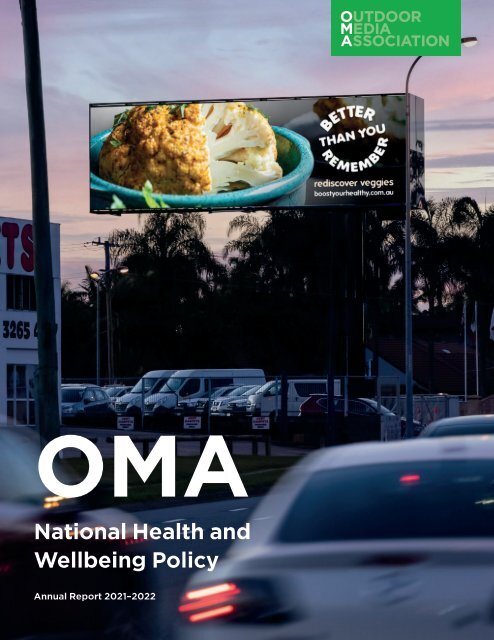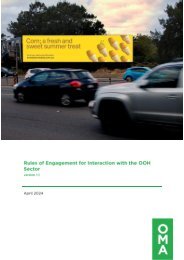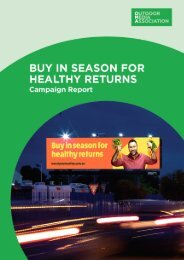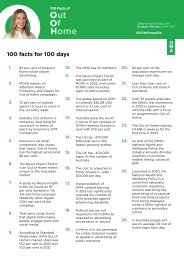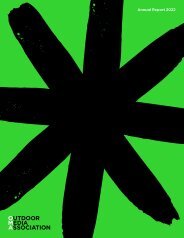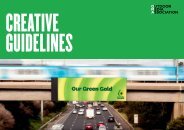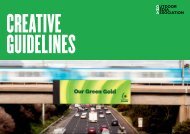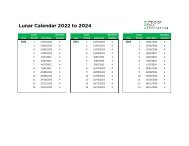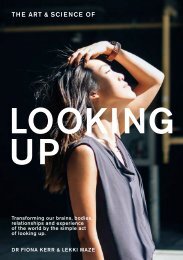OMA Annual Report 2021-2022
Create successful ePaper yourself
Turn your PDF publications into a flip-book with our unique Google optimized e-Paper software.
<strong>OMA</strong><br />
National Health and<br />
Wellbeing Policy<br />
<strong>Annual</strong> <strong>Report</strong> <strong>2021</strong>–<strong>2022</strong><br />
i
Foreword<br />
With green shoots and positive signals ahead, the<br />
Outdoor industry continues to recover from the<br />
COVID-19 pandemic. The two years of lock-down<br />
have not dissuaded our commitment to act in the best<br />
interest of the Australian community, and in <strong>2021</strong> the<br />
industry unified to donate advertising space valued at<br />
$123M to a variety of community-serving causes.<br />
As many still struggle with the after-effects of the<br />
COVID-19 pandemic, attention on mental health<br />
issues is increasing. One key factor for good mental<br />
and physical health is a well-balanced diet, and with<br />
the National Health and Wellbeing Policy operating in its second year, the Outdoor<br />
industry is playing its part to support a healthy community.<br />
A recent study by Fruit & Vegetable Consortium (FVC) reports that 91 per cent of<br />
Australians are not eating the recommended 5+ serves of vegetables each day 1 which<br />
is linked to two thirds of the population living with overweight or obesity, which is 12.5<br />
million Australians. 2 The Outdoor industry in Australia is proud to have launched the<br />
first-ever industry-led National Health and Wellbeing Policy in 2020, and this year we<br />
have continued our commitment to support healthy lifestyle decisions.<br />
Importantly, the restriction of advertising of less healthy food and drink products from<br />
being displayed within a 150m sightline of a primary or secondary school in Australia,<br />
is working. This year, there were zero breaches across the 6,000 signs within this zone.<br />
Additionally, the Outdoor industry’s commitment to annually develop and run a<br />
health and wellbeing campaign valued at $3M of advertising space was implemented<br />
in partnership with Health and Wellbeing Queensland and Nutrition Australia. The<br />
campaign Better than you remember was live from 30 January to 26 February <strong>2022</strong> on<br />
OOH signs nationwide, reaching 10.4 million Australians with <strong>OMA</strong> members donating<br />
advertising space valued at $8M. 3<br />
Operating 24/7 in the public domain and reaching 93 per cent of the Australian<br />
population living in and around capital cities every day, we know that our signs have<br />
the power to influence behavioural change. The National Health and Wellbeing Policy<br />
is just one way that as an industry we can help support government’s actions to halt<br />
the rise and reduce the incidence of overweight and obesity in Australia.<br />
I invite you to review our National Health and Wellbeing Policy <strong>Annual</strong> <strong>Report</strong> for <strong>2022</strong><br />
to see the positive impact we have made this year.<br />
Charmaine Moldrich,<br />
Chief Executive Officer, <strong>OMA</strong> and MOVE<br />
Sources:<br />
1<br />
Fruit <br />
& Vegetable Consortium (FVC), Shifting the Dial on Vegetable Consumption: Quantitative Community<br />
Research, <strong>2022</strong>.<br />
2<br />
Australian <br />
Bureau of Statistics, National Health Survey first results, 2017-2018, abs.gov.au.<br />
3<br />
MOVE <br />
report <strong>OMA</strong> Better than you remember, demographics 14+.<br />
ii
Contents<br />
1. Foreword ii<br />
2. Executive summary 2<br />
3. Introduction 3<br />
4. About the Policy 5<br />
5. Supporting the Policy 6<br />
6. Health and wellbeing campaign 7<br />
7. Investigating creative impact 10<br />
8. Out of Home for good 15<br />
9. Looking forward 16<br />
10. <strong>OMA</strong> members 17<br />
11. References 17<br />
1
2. Executive summary<br />
Foreword<br />
18<br />
food and<br />
beverage<br />
advertisements<br />
reviewed<br />
98<br />
training session<br />
attendees<br />
0<br />
breaches<br />
In 2020, the Outdoor advertising industry created a<br />
world-first, national Policy that restricts the placement of<br />
occasional food and drink advertising from around schools<br />
to reduce the opportunity for children under 15 years of<br />
age to see advertisements for unhealthy food and drinks.<br />
Since the Policy came into effect, the feedback from<br />
government, industry and community has been<br />
overwhelmingly supportive.<br />
In the second year of the Policy’s application, the<br />
Outdoor Media Association (<strong>OMA</strong>) reviewed 18 food and<br />
beverage advertisements for compliance. Of those 18<br />
advertisements, none were rejected from running on <strong>OMA</strong><br />
member signs, which we believe shows that our members<br />
have a thorough understanding of the Policy.<br />
Additionally, the <strong>OMA</strong> trained 98 people on the Health<br />
and Wellbeing Policy. Attendees were from <strong>OMA</strong> member<br />
organisations, agencies and other interested groups.<br />
In November <strong>2021</strong>, the Australian Association of National<br />
Advertisers (AANA) introduced the new Food and<br />
Beverages Advertising Code – applying strict rules to all<br />
food and beverages advertisements in Australia. The <strong>OMA</strong><br />
has worked closely with the AANA to ensure that <strong>OMA</strong><br />
self-regulatory schemes and policies are complementary<br />
to AANA codes.<br />
From July <strong>2022</strong>, the <strong>OMA</strong> transitioned from the Health<br />
Star Rating (HSR) to Food Standards Australia and New<br />
Zealand (FSANZ) as the standard for defining what is<br />
and what is not occasional food. The use of FSANZ in<br />
the <strong>OMA</strong> National Health and Wellbeing Policy makes it<br />
easier for advertisers to ensure their compliance to the<br />
<strong>OMA</strong>’s National Health and Wellbeing Policy and easier<br />
for consumers to gain a better understanding of healthy<br />
nutrition. 1<br />
In January <strong>2022</strong>, the <strong>OMA</strong>, in partnership with Health<br />
and Wellbeing Queensland and Nutrition Australia,<br />
successfully ran the Better than you remember campaign<br />
reaching 10.4 million Australians with $8M advertising<br />
space donated by <strong>OMA</strong> members. 2<br />
2
3. Introduction<br />
3.1.1 World Health Statistics<br />
According to World Health Organisation’s<br />
(WHO) World Health Statistics <strong>2022</strong>,<br />
overweight and obesity are key risk factors for<br />
individuals and for public health. 3 From 2000,<br />
obesity in children, adolescents and adults<br />
has increased in all age groups and in all WHO<br />
regions, including Australia. Overweight and<br />
obesity are major risk factors for asthma, cancer,<br />
cardiovascular disease, dementia, diabetes,<br />
kidney disease, musculoskeletal disorders and<br />
are associated with higher rates of death.<br />
3.1.2 Shifting the dial on vegetable<br />
consumption<br />
In <strong>2022</strong>, KPMG and the Fruit and Vegetable<br />
Consortium published a report on shifting the<br />
dial on vegetable consumption and rebuilding<br />
healthy families in a COVID-19 affected and<br />
disrupted Australia.<br />
The report highlights the adverse effect the<br />
pandemic had on people’s eating behaviour<br />
and how it contributed towards a generation<br />
of Australians facing a health crisis. 4 During<br />
lockdowns, close to half of the population<br />
developed less healthy food habits such as<br />
purchasing more takeaway meals, increased<br />
snacking while working or studying from home,<br />
and overeating caused by stress and anxiety.<br />
Despite a willingness to eat healthier food<br />
and an understanding of the importance of a<br />
nutritious diet, 91 per cent of Australians are<br />
still not eating the recommended 5+ serves<br />
of vegetables each day, as per the Australian<br />
Dietary Guidelines. The research found that<br />
consumers attribute the following reasons<br />
to not eating enough vegetables: they are<br />
expensive, have a short shelf-life and preparing<br />
them is difficult and time consuming.<br />
3.1.3 Australian Government: National<br />
Obesity Strategy<br />
The Australian Government’s Department<br />
of Health and Aged Care National Obesity<br />
Strategy is a 10-year framework for action to<br />
reduce overweight and obesity in Australia. 5<br />
The aim is for Australian children, adolescents<br />
and adults to maintain a healthy weight and to<br />
achieve two targets:<br />
1. Halt the rise and reverse the trend in the<br />
prevalence of obesity in adults by 2030.<br />
2. Reduce overweight and obesity in children<br />
and adolescents aged 2–17 years by at least<br />
five per cent by 2030.<br />
Therefore, three drivers need to be pursued:<br />
1. Creating supportive, sustainable and<br />
healthy environments.<br />
2. Empowering people to stay healthy.<br />
3. Access to early intervention and care.<br />
3.2 About the <strong>OMA</strong><br />
The <strong>OMA</strong> is the peak industry body<br />
that represents companies that display<br />
advertisements, own signs, and provide<br />
services to the industry. Out of Home (OOH) is<br />
advertising for products and services that you<br />
see outside the home, on a variety of signs,<br />
across various locations.<br />
<strong>OMA</strong> members make significant economic<br />
contributions to both government and the<br />
community, contributing $647M to Australia’s<br />
Gross Domestic Product (GDP). Most <strong>OMA</strong><br />
members are Australian owned and operated,<br />
paying taxes in Australia and with profits going<br />
back to the Australian economy.<br />
3.3 The Health and Wellbeing Policy<br />
The <strong>OMA</strong>’s National Health and Wellbeing<br />
Policy builds on its existing Placement Policy<br />
first implemented in 2009. The Placement<br />
Policy restricts the advertising of alcohol,<br />
gaming and wagering, and sexual products and<br />
services from being displayed within a 150m<br />
metre sightline of an Australian primary or<br />
secondary school.<br />
Under the National Health and Wellbeing<br />
Policy, the Placement Policy now also restricts<br />
occasional food and drinks from being<br />
displayed around schools. The <strong>OMA</strong>’s National<br />
Health and Wellbeing Policy was launched on<br />
24 February 2020 and came into effect on<br />
1 July 2020.<br />
3
3.4 The Outdoor industry’s<br />
commitment<br />
As part of the National Health and Wellbeing<br />
Policy was a commitment from the Outdoor<br />
industry to donate $3M of advertising space<br />
each year to a national healthy lifestyle<br />
campaign. The <strong>OMA</strong> works with government<br />
and non-government organisations to develop<br />
the campaign each year, with a focus on<br />
promoting healthy choices.<br />
3.5 About Out of Home advertising<br />
OOH advertising is one of the oldest and<br />
purest forms of media. Prior to the COVID-19<br />
crisis, it had been the only form of traditional<br />
advertising that had seen its audiences grow<br />
year-to-year. This growth is based on increased<br />
urbanisation which has seen audiences grow<br />
31 per cent vs 20.4 per cent population growth<br />
in the last nine years.<br />
OOH advertising comprises many different<br />
formats as classic OOH or digital Out of<br />
Home (DOOH) as well as in different locations<br />
including billboards, bus stops, office foyers<br />
and lifts, public transport, shopping centres,<br />
telephone booths and train stations.<br />
OOH advertising ensures the flexibility and<br />
immediacy required to meet a broad range<br />
of communications demands, from local<br />
business promotions to national commercial<br />
advertising, community issues to public service<br />
announcements.<br />
OOH advertising is a trusted channel used<br />
by federal, state and local government to<br />
broadcast awareness campaigns for public<br />
health and community service messaging.<br />
Add an extra handful of veggies campaign (<strong>2021</strong>)<br />
4
4. About the Policy<br />
4.1 A world first<br />
When it was launched in February 2020, the<br />
National Health and Wellbeing Policy became<br />
the strictest national advertising regulatory<br />
scheme in the world and today remains the<br />
only nationally consistent restriction on the<br />
placement of food advertising. The Outdoor<br />
industry is proud to take this leadership<br />
position.<br />
4.2 Consultative and collaborative<br />
The <strong>OMA</strong> and its members have worked with<br />
food groups, advertisers, health promotion<br />
experts and government to devise the Policy.<br />
The <strong>OMA</strong> is committed to ensuring the Policy<br />
remains best practice for the industry with<br />
a commitment to review and report on its<br />
efficacy each year.<br />
4.3 Evidence-based<br />
The <strong>OMA</strong> has undertaken extensive research<br />
on Australian and international best practice to<br />
formulate the Policy.<br />
4.4 Place-based<br />
The Policy uses schools as a touchpoint<br />
because there is at least one in every suburb,<br />
as well as being centrally located. Schools<br />
are the hubs of communities everywhere; the<br />
buildings and grounds are used for more than<br />
just school activities – they are embraced by<br />
local communities every day.<br />
Compliance with the Policy is made possible<br />
through the Outdoor industry’s investment in<br />
the MOVE school mapping tool, a web-based<br />
interactive tool for media buyers, advertisers<br />
and <strong>OMA</strong> members.<br />
The MOVE school mapping tool allows<br />
<strong>OMA</strong> members to map the location of their<br />
individual signs to primary and secondary<br />
schools, accurately highlighting which signs are<br />
captured by the Policy.<br />
4.5 Emphasis on education<br />
Noting that overweight and obesity are<br />
complex problems which require multi-faceted<br />
solutions, the <strong>OMA</strong> has developed the Policy<br />
with a view to educating communities on<br />
healthy lifestyles.<br />
In addition to restricting occasional food<br />
and drinks from being displayed around<br />
schools, the Outdoor industry has committed<br />
to donating $3M of advertising space to a<br />
healthy food campaign each year.<br />
<strong>OMA</strong> members, with decades of experience<br />
in creating successful campaigns, also offer<br />
creative support and advice to maximise<br />
the success of each campaign, and the <strong>OMA</strong><br />
monitors the efficiacy of the campaigns.<br />
4.6 Transparent monitoring<br />
The <strong>OMA</strong> monitors the implementation<br />
and effects of the Policy and shares the results<br />
with government annually.<br />
“We’re committed to addressing health issues and<br />
promoting the importance of veggies in everyone’s diet,<br />
which is why it’s so rewarding to be working with the<br />
Outdoor industry to achieve this goal.”<br />
Dr Robyn Littlewood, Health and Wellbeing Queensland Chief Executive<br />
5
5. Supporting the Policy<br />
5.1 Copy Advice<br />
In the 12 months between July <strong>2021</strong> and<br />
June <strong>2022</strong>, the <strong>OMA</strong> Copy Advice service<br />
reviewed 18 food and beverage advertisements<br />
pertaining to the National Health and<br />
Wellbeing Policy. Of these, none were rejected<br />
for display within the restricted zone.<br />
This low number, combined with zero breaches<br />
this year, indicates that <strong>OMA</strong> members<br />
understand the policy and their internal review<br />
processes are working well.<br />
5.3 Training sessions<br />
The <strong>OMA</strong> holds regular training sessions on all<br />
of its policies and self-regulatory codes.<br />
These training sessions are designed to help<br />
members apply the rules around advertising<br />
food and beverage products, alcohol, gambling<br />
and wagering, sexual services, political<br />
advertising and the placement of such content.<br />
In <strong>2021</strong> and <strong>2022</strong>, the training sessions were<br />
attended by 322 participants and the recorded<br />
webinar remains available for <strong>OMA</strong> members<br />
on the <strong>OMA</strong> website.<br />
5.2 Website<br />
The <strong>OMA</strong> launched www.healthyoutdoor.org<br />
as one source for all information regarding the<br />
Policy. The website hosts education resources<br />
and information materials as well as details<br />
about the national health and wellbeing<br />
campaigns Add an extra handful of veggies<br />
(<strong>2021</strong>) and Better than you remember (<strong>2022</strong>).<br />
The website received 1,000 visits during the<br />
first month of the launch of the Policy and has<br />
had more than 3,400 visits since its launch.<br />
Better than you remember campaign (<strong>2022</strong>)<br />
Better than you remember campaign (<strong>2022</strong>)<br />
6
6. Health and wellbeing campaign<br />
6.1 Better than you remember<br />
The Better than you remember campaign<br />
marked the second year of the <strong>OMA</strong> partnering<br />
with government on a national healthy<br />
lifestyle campaign. With the growth in <strong>OMA</strong><br />
membership, allocation of signs exceeded the<br />
requested amount, totalling $8M in advertising<br />
space donated. 2<br />
Developed by Health and Wellbeing<br />
Queensland and Nutrition Australia, three<br />
campaign creatives ran from 30 January to<br />
26 February <strong>2022</strong> on Outdoor signs reaching<br />
10.4 million people nationwide. It encouraged<br />
Australians to rediscover and think differently<br />
about how they consume vegetables.<br />
6.2 Results<br />
The aim of the national health and wellbeing<br />
campaigns is to educate the Australian<br />
community and to influence positive behaviour<br />
change. To gauge success, the <strong>OMA</strong> works<br />
with independent market research companies<br />
to conduct surveys and analysis after each<br />
industry campaign.<br />
“It is expected this initiative involving donated advertising space will reach up to<br />
12 million Australians. I congratulate members of the Outdoor Media Association<br />
for utilising their signs to make a positive difference to the health of Australians –<br />
including children returning to school – across the country.”<br />
Hon Greg Hunt, former Minister for Health and Aged Care<br />
Better than you remember campaign (<strong>2022</strong>)<br />
7
6.3 Nationwide survey results<br />
The <strong>OMA</strong> conducted a post-campaign study surveying 1,217 Australians in total with 50 per<br />
cent parents, 50 percent not parents.<br />
27% 40% 55% 13%<br />
of people remembered<br />
seeing the campaign<br />
creative on Out of<br />
Home signs.<br />
of parents were<br />
encouraged to add<br />
vegetables to their<br />
children’s meals.<br />
of people were<br />
encouraged to<br />
visit the campaign<br />
website.<br />
of people talked<br />
to family and<br />
friends about the<br />
campaign.<br />
The research found that the message Better than you remember had high cut through among<br />
parents with 40 per cent of parents saying they were encouraged to include vegetables in their<br />
meals and to make healthier choices for their children’s meals. 6 The Better than you remember<br />
campaign motivated two out of three people to visit www.boostyourhealthy.com.au and 13 per<br />
cent of people talked to family and friends about the campaign.<br />
Better than you remember campaign (<strong>2022</strong>)<br />
8
6.4 Format-specific survey results<br />
The <strong>OMA</strong> ran a secondary survey with <strong>OMA</strong> member Shopper, who have signs in shopping<br />
centres, to gauge cut-through for the campaign specifically with people in shopping centre<br />
environments. Using the Shopper Study Survey platform, this post-campaign study surveyed<br />
3,547 Australians.<br />
65% 73% 31%<br />
of people remembered<br />
seeing the campaign<br />
creative on Out of<br />
Home signs.<br />
of parents were<br />
encouraged to add<br />
vegetables to their<br />
children’s meals.<br />
of people were<br />
encouraged to<br />
visit the campaign<br />
website.<br />
The results show greater cut-through for the campaign within shopping environments, where it<br />
was most relevant in the moment. 7 Parents with children under 15 years of age, had the highest<br />
recall of the campaign with 70 per cent, and 73 per cent of those said they purchased more<br />
veggies as a result.<br />
Better than you remember campaign (<strong>2022</strong>)<br />
9
7. Investigating creative impact<br />
7.1 Campaign comparison<br />
At the end of the Better than you remember campaign, the <strong>OMA</strong> evaluated the combined<br />
impact of the two national health and wellbeing campaigns that have run to-date.<br />
The post-campaign survey from the <strong>2021</strong> campaign, Add an extra handful of veggies, showed a<br />
high level of recall and consideration with one in two people recalling the campaign. 8<br />
48% 86% 60% 65%<br />
of people remembered<br />
seeing the campaign<br />
creative on Out of<br />
Home signs.<br />
of parents were<br />
encouraged to add<br />
vegetables to their<br />
children’s meals.<br />
of people were<br />
encouraged to<br />
visit the campaign<br />
website.<br />
of people talked<br />
to family and<br />
friends about<br />
the campaign.<br />
The message Add an extra handful of veggies had high cut-through among parents with 86 per<br />
cent of parents saying they were encouraged to include vegetables in their meals and 80 per cent<br />
of parents saying they were encouraged to make healthier choices for their children’s meals.<br />
The Add an extra handful of veggies campaign motivated two out of three people to visit<br />
www.eatforhealth.com.au and 65 per cent of people to talk to family and friends about the<br />
campaign.<br />
These survey results demonstrate that the Add an extra handful of veggies campaign message<br />
was memorable, influenced positive behaviour change and sparked conversations.<br />
Add an extra handful of veggies campaign (<strong>2021</strong>)<br />
10
Post-Campaign Survey Results<br />
27%<br />
65%<br />
48%<br />
40%<br />
73%<br />
86%<br />
55%<br />
31%<br />
60%<br />
13%<br />
n/a<br />
65%<br />
Recall<br />
of people remembered<br />
seeing the campaign in<br />
Out of Home media<br />
Action<br />
of parents were<br />
encouraged to include<br />
veggies in their<br />
children’s meals<br />
Information<br />
of people were<br />
encouraged to visit the<br />
campaign website<br />
Talkability<br />
of people talked to<br />
family and friends about<br />
the campaign<br />
Dynata Survey commissioned by the <strong>OMA</strong> for Better than you remember n=1,217<br />
Shopper Study Survey <strong>OMA</strong> Better than you remember n=3,547<br />
Dynata Survey commissioned by the <strong>OMA</strong> for Add an extra handful of veggies<br />
n=1,200; parents with children under 15 n=775
7.2 Neuroscience study<br />
Given the wide variation in recall rates of the two campaigns, the <strong>OMA</strong> engaged Neuro-Insight, a<br />
neuro-analytics company, to investigate the creative impact.<br />
The Neuro Impact Factor (NIF) is a specialised approach that quantifies the subconscious impact<br />
of a media environment as individuals naturally experience it. The NIF is based on Neuro-Insight’s<br />
scientifically and market validated metrics; long term memory encoding and emotional intensity<br />
with the specific behaviour of each metric also incorporated into the formula. Both measures are<br />
key subconscious drivers in how memory is processed and subsequently stored. The “peaks” play<br />
an important role in memory creation and have been shown to predict future behaviour.<br />
Neuro-Insight evaluated six health and wellbeing campaign creatives to define the most effective<br />
creative execution. The creatives were measured via long term memory encoding, engagement,<br />
approach/withdraw, emotional intensity and desirability to ascertain the most effective form of<br />
creative – the Neuro Impact Factor. Eventually, the creatives were indexed against each other to<br />
show the one which has the most impact.<br />
The evaluation took place in Melbourne with a sample composed of even gender and<br />
demographic split. Participants were exposed to a 30-minute test reel on a standard flat<br />
screen television. The reel consisted of a driving simulation with Out of Home signs throughout<br />
Melbourne. The selected creatives were embedded in Out of Home signs during the viewing<br />
experience and shown for ten seconds.<br />
The neuroscience study shows that the Add an extra handful of veggies campaign creative generated the<br />
most brain activity. 9<br />
12
130<br />
125<br />
Neuro Impact<br />
120<br />
115<br />
110<br />
DATA IS BASED ON FIRST EXPOSURE –<br />
THE LEADING NEURO INDICATOR OF IMPACT.<br />
NOTE: DATA IS INDEXED<br />
112<br />
114<br />
118<br />
125<br />
105<br />
100<br />
95<br />
100<br />
90<br />
85<br />
The first exposure data show the initial brain activity in reaction to the shown campaign creative.<br />
The creatives are ranked from left to right with increasing Neuro Impact Factor score. The portrait<br />
version of the Add an extra handful of veggies campaign creative received the highest Neuro<br />
Impact Factor score. 9<br />
130<br />
125<br />
SECOND EXPOSURE DATA<br />
NOTE: DATA IS INDEXED<br />
Neuro Impact<br />
120<br />
115<br />
110<br />
105<br />
123<br />
120<br />
ADD AN EXTRA HANDFUL<br />
CREATIVE BENEFITS LESS<br />
ON A SECOND EXPOSURE<br />
BECAUSE IT ALREADY<br />
HAS A STRONGER<br />
NEURO IMPACT FACTOR<br />
100<br />
95<br />
100<br />
100<br />
100<br />
90<br />
92<br />
85<br />
The second exposure data provide insight into the role of frequency and how recipients react<br />
to the repeated shown campaign creative. The Better than you remember campaign creative<br />
benefitted the most and received the highest Neuro Impact Factor score. 9<br />
13
7.3 Eye tracking study<br />
An Artificial Intelligence (AI) predictive eye-tracking model was applied to each campaign<br />
creative to show the distribution of attention.<br />
The Add an extra handful of veggies campaign<br />
creative in portrait version received strong<br />
results with 51 per cent of visual attention on<br />
the messaging, 17 per cent of visual attention<br />
on the child, six per cent of visual attention on<br />
the vegetable and less than one per cent of<br />
visual attention on the link to the website. 9<br />
The Better than you remember campaign<br />
creative in portrait version received successful<br />
results with 52 per cent of visual attention on<br />
the veggies, 18 per cent of visual attention<br />
on the messaging and 14 per cent of visual<br />
attention on the link to the website. 9<br />
7.4 Summary of Neuroscience study<br />
To summarise the Neuroscience study results:<br />
• The Add an extra handful of veggies campaign creative received the highest Neuro Impact<br />
Factor results with most attention on the messaging and least attention on the link to<br />
the website.<br />
• The Better than you remember campaign creative benefitted most from second exposure<br />
demonstrating that frequency and the repeated shown campaign creative help to build a<br />
higher Neuro Impact Factor score.<br />
• The Add an extra handful of veggies campaign contained one creative. The Better than you<br />
remember campaign contained three creatives. As the Add an extra handful of veggies<br />
campaign received the highest brain activity, Neuro Impact Factor results and gaze activity, the<br />
fact that one creative was consistently used, helped the campaign’s overall performance.<br />
• The small format portrait creatives benefitted the most from second exposure and received the<br />
most attention on the campaign’s message.<br />
14
8. Out of Home for good<br />
8.1 Community service campaigns<br />
The Outdoor industry understands the<br />
important role OOH advertising plays in the<br />
public space and takes this responsibility<br />
seriously. The <strong>OMA</strong> and its members regularly<br />
run community service campaigns across<br />
Australia to raise awareness for community<br />
issues and to broadcast crucial information.<br />
In <strong>2021</strong>, the Outdoor industry donated<br />
media space and advertising production for<br />
community service campaigns valued at an<br />
estimated $123M and supported over 140<br />
beneficiaries including charities, healthcare and<br />
environmental organisations, public bodies and<br />
arts and cultural organisations.<br />
Additionally, the <strong>OMA</strong> works closely<br />
with community groups, local and state<br />
government to ensure that Outdoor<br />
advertising is planned and executed to<br />
support the Australian community.<br />
8.2 Code of Ethics<br />
The Outdoor industry follows a strict selfregulatory<br />
scheme ensuring that content<br />
meets prevailing community standards.<br />
For all <strong>OMA</strong> members, compliance with the<br />
self-regulatory scheme is a condition of<br />
membership.<br />
The <strong>OMA</strong> works closely with the Australian<br />
government and a range of other stakeholders<br />
to ensure that its self-regulation and <strong>OMA</strong><br />
Codes of Ethics policies are appropriate,<br />
responsive and practical.<br />
Also, <strong>OMA</strong> members and advertising publishers<br />
are subject to the Australian Association of<br />
National Advertisers (AANA) Code of Ethics<br />
– which is the main self-regulatory scheme for<br />
the Australian advertising industry. 10<br />
These <strong>OMA</strong> self-regulatory policies and the<br />
AANA Code of Ethics ensures the Outdoor<br />
industry and its stakeholders follow any<br />
changes in community standards and<br />
government priorities.<br />
8.3 Advisory Service<br />
In <strong>2021</strong>, the <strong>OMA</strong> reviewed 368 ads. Of these<br />
66 were rejected and 30 were modified to<br />
comply with the codes.<br />
Because <strong>OMA</strong> members have been complying<br />
with <strong>OMA</strong> self-regulatory schemes and policies<br />
as well as the AANA Code of Ethics since<br />
1997, compliance with the National Health and<br />
Wellbeing Policy is now part of the everyday<br />
process of posting ads.<br />
The <strong>OMA</strong> Code of Ethics states that <strong>OMA</strong><br />
members cannot endorse the display of<br />
advertisements likely to breach the AANA<br />
Code of Ethics.<br />
The <strong>OMA</strong>’s Copy and Concept Advisory<br />
Service helps eliminate the likelihood of an<br />
OOH advertisement breaching one or more of<br />
the 18 self-regulatory codes and policies <strong>OMA</strong><br />
members adhere to.<br />
The service is complemented by regular<br />
training sessions for <strong>OMA</strong> members and<br />
relevant stakeholders.<br />
The <strong>OMA</strong> takes responsibility for keeping the<br />
self-regulatory schemes and policies up to date<br />
and educating <strong>OMA</strong> members on any changes.<br />
“We love seeing veggies on billboards and believe more promotion like this is<br />
needed. Vegetables are at the very centre of healthy eating and a critical part<br />
of our diet for people of all ages. They can safeguard us from chronic health<br />
conditions – such as diabetes, stroke, heart disease and obesity, but we still don’t<br />
eat as many as we should. We are thrilled to be involved in this year’s campaign<br />
and provide tips and recipes that can make healthy eating tasty and accessible.<br />
This campaign is topical as you can boost your immune system by upping your<br />
veggie intake. A great annual initiative by the <strong>OMA</strong> and their members.”<br />
Lucinda Hancock, CEO of Nutrition Australia Vic, SA, Tas, WA Divisions<br />
15
9. Looking forward<br />
9.1 Self-regulatory Policies<br />
The <strong>OMA</strong> is committed to reviewing its selfregulatory<br />
framework following its 18 policies<br />
and codes of practice. The National Health and<br />
Wellbeing Policy is one of them and is being<br />
reviewed annually by the <strong>OMA</strong> Board.<br />
The review process involves consultation with<br />
<strong>OMA</strong> members and, where relevant, other<br />
relevant stakeholders including Australian<br />
the Federal Government, Australian State<br />
Governments as well as the AANA.<br />
During that time, the <strong>OMA</strong> will review feedback<br />
received from stakeholders as well as consult<br />
with <strong>OMA</strong> members on the operation of the<br />
policy and make any changes required to ensure<br />
the policy remains robust and fit for purpose.<br />
9.2 New Food and Beverages<br />
Advertising Code<br />
The new AANA Food and Beverages<br />
Advertising Code took effect on 1 November<br />
<strong>2021</strong>. The AANA Code applies strict rules to all<br />
food and beverage advertisements in Australia,<br />
reducing the opportunity for children under<br />
15 years of age to see advertisements for<br />
unhealthy food and drinks. 10<br />
The <strong>OMA</strong> has worked closely with the AANA to<br />
ensure that <strong>OMA</strong> self-regulatory schemes and<br />
policies and AANA codes are complementary,<br />
making the wider system of self-regulation,<br />
policies and codes more robust.<br />
The <strong>OMA</strong> continues to work with the AANA<br />
and other relevant stakeholders to ensure that<br />
the system continues to operate optimally.<br />
9.2.1 A more robust system<br />
In 2020, when the world-first National Health<br />
and Wellbeing Policy was launched, the <strong>OMA</strong><br />
selected the Health Star Rating (HSR) system<br />
as the standard for defining what is and what is<br />
not occasional food and drink.<br />
The HSR system was considered optimal<br />
because it aimed to build a better understanding<br />
for healthy nutrition amongst the population<br />
and was easy to understand by consumers.<br />
In <strong>2021</strong>, the new AANA Food and Beverages<br />
Code came into effect utilising the Food<br />
Standards Australia and New Zealand (FSANZ)<br />
Nutrient Profile Criteria to define occasional<br />
food and drink products.<br />
Both systems are governed by similar<br />
equations and speak to the nutrient profile of<br />
a food to determine its status as occasional or<br />
every day.<br />
From July <strong>2022</strong>, the <strong>OMA</strong> transitioned from<br />
the use of HSR system to the FSANZ within<br />
the National Health and Wellbeing Policy –<br />
acknowledging that self-regulatory schemes<br />
and policies must be adaptive to remain<br />
robust.<br />
The benefit of having one standardised<br />
definition of occasional food among the wider<br />
Outdoor industry is that the system becomes<br />
stronger and more effective.<br />
9.3 Breaches<br />
Ad Standards manages the complaint<br />
resolution process of the advertising selfregulation<br />
system in Australia. The Ad<br />
Standards Community Panel is an independent<br />
body established to determine consumer<br />
complaints against the self-regulatory codes.<br />
Usually, advertisers are very careful not to<br />
breach regulations. The visible placement of<br />
OOH advertising in the public space means<br />
a great responsibility to the audience and<br />
to the community. However, there is always<br />
the chance for incorrect judgement calls and<br />
human error to occur. As per <strong>OMA</strong> members’<br />
commitment, affected advertisements must be<br />
removed within 24 hours.<br />
Last year, the <strong>OMA</strong> continued to uphold the<br />
gold standard in advertising content with no<br />
breaches issued by Ad Standards.<br />
9.4 Prospective campaigns<br />
The <strong>OMA</strong> has begun work on the 2023 healthy<br />
lifestyle campaign in partnership with Health<br />
and Wellbeing Queensland and Nutrition<br />
Australia for the second year.<br />
And, with new members signing up to the<br />
Association in <strong>2022</strong> who specialise in point<br />
of sale, retail and health environments, it is<br />
hoped that the 2023 campaign will have even<br />
greater impact.<br />
16
10. <strong>OMA</strong> members<br />
Media Owners<br />
Suppliers<br />
Asset Owners<br />
11. References<br />
1. Food Standards Australia and New Zealand (FSANZ), Food Standards Code, www.foodstandards.gov.au/code/Pages/default.aspx.<br />
2. MOVE report <strong>OMA</strong> Better than you remember, demographics 14+<br />
3. World Health Organisation (WHO), World Health Statistics <strong>2022</strong>, Licence: CC BY-NC-SA 3.0 IGO.<br />
4. KPMG Australia, Shifting the dial on vegetable consumption, <strong>2022</strong>, https://www.thefvc.org.au/s/FVC-<strong>Report</strong>_ Final_041022.pdf.<br />
5. Commonwealth of Australia, The National Obesity Strategy <strong>2022</strong>-2032, Health Ministers Meeting.<br />
6. Dynata Survey commissioned by the <strong>OMA</strong> for Better than you remember n=1,217<br />
7. Shopper Study Survey <strong>OMA</strong> Better than you remember n=3,547<br />
8. Dynata Survey commissioned by the <strong>OMA</strong> for Add an extra handful of veggies n=1,200; parents with children under 15 n=775<br />
9. Neuro-Insight Case Study commissioned by the <strong>OMA</strong> for Add an extra handful of veggies (<strong>2021</strong>) and Better than you remember (<strong>2022</strong>). Neuroscience to test impact, n=50.<br />
10. Australian Association of National Advertisers (AANA), Code of Ethics, <strong>2022</strong>, www.aana.com.au/wp-content/ uploads/<strong>2021</strong>/06/AANA_FoodBev_Advertising_Code_final.pdf.<br />
17
Outdoor Media Association,<br />
Suite 504, 80 William Street, East Sydney, NSW 2011<br />
info@oma.org.au<br />
This report is available at oma.org.au<br />
All photographs © Outdoor Media Association and its members<br />
Publisher: Outdoor Media Association<br />
ISSN - 1839 - 0315 (print)<br />
ISSN - 1839 - 0323 (online)<br />
18


